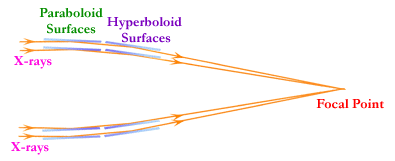How do X-ray telescopes differ from optical
telescopes?
X-rays do not reflect off mirrors the same way that visible light does. Because
of their high-energy, X-ray photons penetrate into the mirror in much the same
way that bullets slam into a wall. Likewise, just as bullets ricochet when they
hit a wall at a grazing angle, so too will x-rays ricochet off mirrors (see
diagram below). These properties mean that X-ray telescopes must be very
different from optical telescopes.
The mirrors have to be precisely shaped and aligned nearly parallel to incoming x-rays. Thus they look more like barrels than the familiar dish shape of optical telescopes.
- More Information - Reflection (java enhanced)



